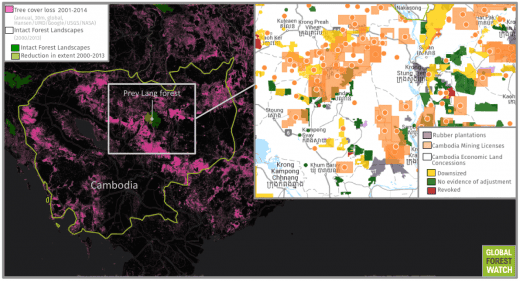- Cambodia’s Prey Lang forest has been under threat from illegal loggers for nearly 20 years, with deforestation spiking to 100 square kilometers (39 square miles) in 2016, the same year a wildlife sanctuary was declared.
- A grassroots group that seeks to protect the ecosystem says it continues to find “alarming” evidence of illegal logging in and around the forest and protected area.
- These activists say they fear loggers are able to escape because of a 2017 government regulation requiring them to seek permission before conducting any more patrols.
For nearly 20 years, the Prey Lang forest that spans four Cambodian provinces has been shrinking.
What started as a relative trickle in 2000 was on a serious uptick by 2013. But by 2016, when 432,000 hectares of the forest was designated as a protected wildlife area, illegal logging there was so rampant that some 100 square kilometers (39 square miles) of forest cover were cleared that same year.
Today, the continual degradation of forest cover within the protected area is happening “at an alarming rate,” according to the Prey Lang Community Network (PLCN), a grassroots group of volunteers who come from communities in and around the forest.

According to the organization’s latest monitoring report, which focused on suspected logging activities between September 2017 and May 2018, satellite imagery collected by the University of Maryland showed a forest loss of 56 square kilometres (22 square miles) in 2017, equivalent to the destruction of 21 football fields per day.
The group uses an app to keep track of illegal logging activities; these accounted for 99 percent of the reports made through the app in the reporting period.
In 41 percent of these cases, PLCN members had come across and reported finding “single stumps,” which usually indicate that trees have been logged and harvested. Twenty-four percent of the entries represented findings of planks that had been logged and likely left behind, the report said, as well as evidence of transport to move the wood elsewhere.
“Remarkably, every day, many tractors loaded with timber pass unencumbered through forest ranger checkpoints,” the PLCN report says. “The timber is not being confiscated and the offenders face no legal consequences for their crimes.”
The PLCN said regulations imposed by the Ministry of Environment (MoE) in 2017 made it mandatory to seek permission when they want to patrol certain areas of the forest, and allege that it is allowing loggers to flee before being caught. They also suspect that some loggers are being systematically warned in advance by local officials themselves.
“The government issued a new regulation in 2017 requiring communities to inform the Ministry of Environment and local authorities three days prior to conducting patrols, so that MoE can assign forest rangers to join the patrols and allow PLCN to enter the forest,” the report says. “This requirement hampers the work of PLCN and there is a general feeling that illegal loggers are being tipped off by some local authorities and/or forest rangers, making the patrols less effective.”
Prey Lang is home to 530 species of trees and plants, 11 of which are threatened, as well as 393 animal species. Of these, 55 are considered under threat.
The thirst for Cambodian timber has fed markets in Vietnam and China for years. In 2016, the Cambodian government issued a formal ban on timber exports, but this has failed to stem the illegal flow of wood into Vietnam and on to China, where demand has driven the value of a cubic meter of rosewood, for example, to about $50,000, or more than $1,400 per cubic foot.
In an email to Mongabay, MoE spokesman Neth Pheaktra said government patrols were able to curtail the issue, and that illegal acts in Prey Lang had actually fallen by 30 percent compared to 2017.

“According to a report from four provinces attached to Prey Lang: Kampong Thom, Preah Vihear, Stung Treng, Kratie, from Jan to Dec 2018, MoE rangers and sometimes with the participation from Prey Lang Community Network had patrolled 1,524 times and met around 400 case of illegal acts,” Pheaktra said.
He also rejected the data in the report as “polluted information fabricated by an international NGO,” referring to Danmission, a Danish group that helped build the app.
“It is not credible report,” Pheaktra wrote in his email. “They used app to count the illegal logging with old statistics … and only negative points. They counted every single cut tree, [and] stumps not whole … at a found area. That’s why make the number of illegal logging activity increased in their report.”
He added the MoE “accepts the suggestion from PLCN” about seeking permission to patrol, and is “preparing the team to be ready at all the times in order to act quickly.”
For now, however, if the regulation is ever lifted, the grassroots forest guardians will have to wait for the green light to conduct their patrols. And the loggers, as the group fears, will continue to be able to chip away at Prey Lang.
Banner image: The vast evergreen woodlands of Prey Lang are home to dozens of endangered plant and animal species — and luxury timbers sought after by loggers. Photo courtesy of the Prey Lang Community Network/Wikimedia Commons.
About the reporter: Lauren Crothers is a New York City-based freelance photojournalist with extensive reporting experience in Southeast Asia. You can find her on Instagram at @laurencro.
FEEDBACK: Use this form to send a message to the editor of this article. If you want to post a public comment, you can do that at the bottom of the page.













